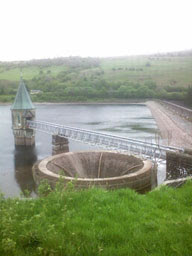The Welsh Myst
Jun
09

Barry Atkins offered this image on his blog SHUSH along with this bit of descriptions:
“I took this last time I actually got out to see some of the beautiful countryside we live in. Phone camera picture, unfortunately, it really struck me that it was an arrangement of features that shouted ‘game’ to me. As far as I could work out the thing that looks like a huge overflow plug hole is… a huge overflow plug hole. Better than a Narnia wardrobe or a great big glowing gate to signal a possibility of an imminent somewhere else. Nice rickety steel gangway right over the top of the plug hole to the austere tower where something waits.”
Whether you read this image as showing that real life is more like Myst than you thought, that environments can be always be viewed as fundamentally lugological or whether game designers should just try harder, it’s an interesting image. And it would make a cool Tony Hawk level too.
I again find myself issuing another caveat here, in response to this strange image being interpreted as ‘lugololical’ [sic] (I actually prefer the goofy misspelling to the original)
I am at a loss to find any references in the writings of any of the more prominent, so-called ‘ludologists’ to the experience of space, architecture or a sense of place and environment as such (I.e. as experience). To my mind, it would seem their insistence on systemic, structural arrangements of ‘rules’ and formal properties would have problems accounting for this instance of the experience and sensibility of a space. There is no reference that I have come across linking the work of ludologists to something more phenomenological- which would be more appropriate to interrogate the surreal, mixed sense of space and place imbued by this image.
Again, I can only reiterate what many of my previous, Sisyphean online postings have attempted to argue- that ludology constitutes a convenient term without a real or useful referent. Games are more than the sum of just their ‘rules’ or percieved structural arrangements. They are a complex interface between humans, digital machinery, imagery, sense-experience and the simulated horizon of the virtual. We need more than just a sophomoric distillation of games into code in order to understand the meaning(s) of our complex interactions with them.
There some folks thinking about space and games. James Newman, in his book “Videogames” notes that Aarseth has pointed out the basic spatial nature of games as well as pointing to Jenkins thoughts about games and their similarities to travelogues.
But, you are right, the “ludological” (oops on the spelling in the post. But I’ll leave it now that you’ve pointed it out!) view does tend toward this unfortunate structuralism. Still, it seems to me that pointing out how well the study of games, whether done from a narratological or ludological or whatever perspective, can offer some insight into real world environments. Phenomenologically speaking, videogames seem to work because we can experience them as if they were taking place in real space. I think Barry’s image show the flip side. The world is filled with all kinds of visual puzzles and curious spatial surprises that work like games. That’s what I’m most interested in these days.
— David